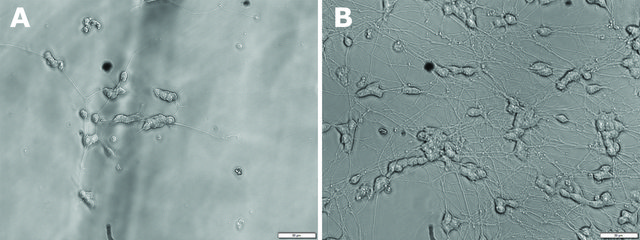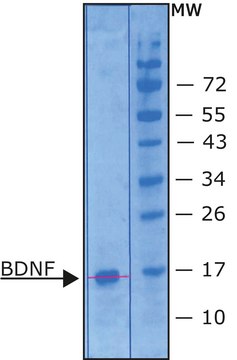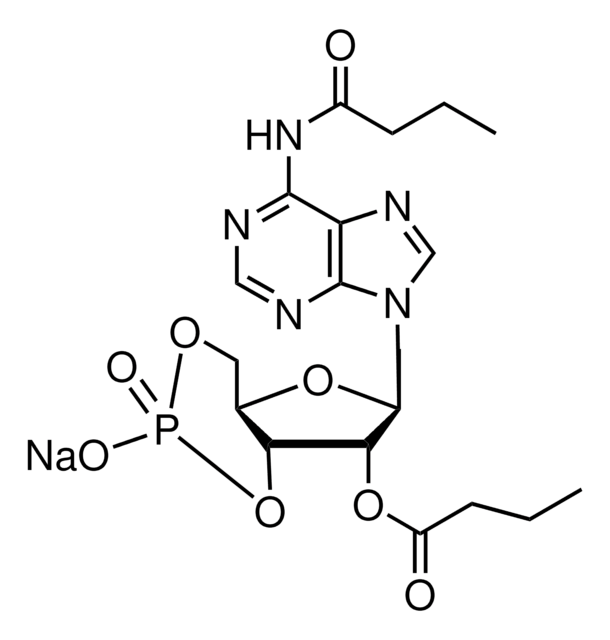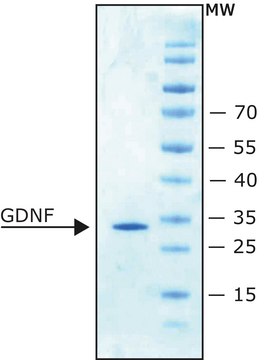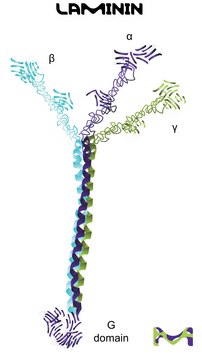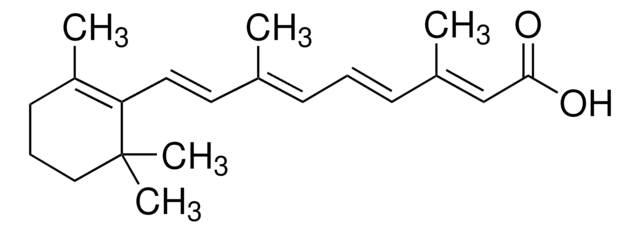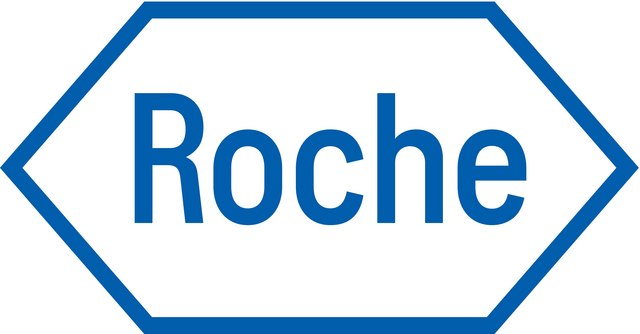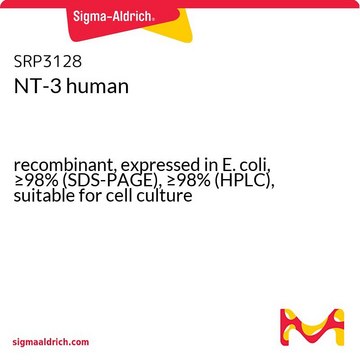推荐产品
产品名称
Ciliary Neurotrophic Factor human, CNTF, recombinant, expressed in E. coli, lyophilized powder, suitable for cell culture
生物来源
human
质量水平
重组
expressed in E. coli
方案
≥95% (SDS-PAGE)
表单
lyophilized powder
效能
≤325 ng/mL ED50 ((≥ 3.1 x 103 units/mg))
质量
endotoxin tested
分子量
22.8 kDa
包装
pkg of 10 and 20 μg
储存条件
avoid repeated freeze/thaw cycles
技术
cell culture | mammalian: suitable
杂质
≤10 EU/μg
UniProt登记号
储存温度
−20°C
基因信息
human ... CNTF(1270) , CNTF (1270)
一般描述
The CNTF (ciliary neurotrophic factor) gene encodes a cytokine, and is mapped to human chromosome 11q12.1.
应用
Ciliary Neurotrophic Factor human has been used to study its effect on photoreceptor neuroprotection and Muller glial cell proliferation in zebrafish retina. It has also been used to study the effects of intravitreal injection of ciliary neurotrophic factor (CNTF) on photoreceptor injury and BRB (blood-retinal barrier) breakdown in transgenic model.
生化/生理作用
Ciliary neurotrophic factor (CNTF) was first identified as a survival factor for neurons from the ciliary ganglion of chicken embryos. Most of its known actions are restricted to cells of the nervous system, including motor neurons, sympathetic ganglion neurons, sensory neurons, hippocampal neurons, and medial septal neurons. CNTF also prevents degeneration of motor axons after axotomy and promotes astrocyte differentiation and oligodendrocyte survival and maturation. Outside the nervous system, CNTF maintains embryonic stem cells in an undifferentiated, pluripotent state. CNTF is structurally related to leukemia inhibitory factor (LIF), interleukin-6 (IL-6), interleukin-11 (IL-11) and oncostatin M (OSM). CNTF exerts its actions through the activation of the high-affinity CTNF receptor complex, which contains the ligand-binding α-subunit (CNTF Rα) and two signal transducing β-subunits (LIF Rβ and gp130). The LIF Rβ subunit is also shared by receptors for LIF and OSM. The gp130 subunit is also shared by receptors for LIF, OSM, IL-6, and IL-11. CNTF is localized in the cell nucleus subsequent to receptor binding. Human and rat CNTF share ~83% sequence homology and show cross-reactivity in bioactivity.
Ciliary neurotrophic factor was first identified as a survival factor for neurons from the ciliary ganglion of chicken embryos. Most of its known actions are restricted to cells of the nervous system, including motor neurons, sympathetic ganglion neurons, sensory neurons, hippocampal neurons and medial septal neurons. CNTF also prevents degeneration of motor axons after axotomy and promotes astrocyte differentiation and oligodendrocyte survival and maturation.
外形
Lyophilized from a sterile (0.2 micron) filtered aqueous solution containing 10 mM sodium phosphate, pH 7.5
分析说明
The proliferative activity is tested in a cell proliferation assay using the cytokine-dependent human erythroleukemic cell line, TF-1.
储存分类代码
13 - Non Combustible Solids
WGK
WGK 3
闪点(°F)
Not applicable
闪点(°C)
Not applicable
个人防护装备
Eyeshields, Gloves, type N95 (US)
法规信息
新产品
CNTF induces photoreceptor neuroprotection and Muller glial cell proliferation through two different signaling pathways in the adult zebrafish retina
Kassen SC, et al.
Experimental Eye Research, 88(6), 1051-1064 (2009)
Genomic variants, genes, and pathways of Alzheimer's disease: an overview
Naj AC, et al.
American Journal of Medical Genetics. Part B, Neuropsychiatric Genetics : the Official Publication of the International Society of Psychiatric Genetics, 174(1), 5-26 (2017)
Rachelle W Johnson et al.
Bone, 64, 47-56 (2014-04-12)
Muscle and bone are intimately linked by bi-directional signals regulating both muscle and bone cell gene expression and proliferation. It is generally accepted that muscle cells secrete factors (myokines) that influence adjacent bone cells, but these myokines are yet to
Weiyong Shen et al.
The Journal of neuroscience : the official journal of the Society for Neuroscience, 32(45), 15715-15727 (2012-11-09)
Müller cells are the major glia of the retina that serve numerous functions essential to retinal homeostasis, yet the contribution of Müller glial dysfunction to retinal diseases remains largely unknown. We have developed a transgenic model using a portion of
Mansour Haidar et al.
Autophagy, 15(6), 1051-1068 (2019-01-24)
HSPB1 (heat shock protein family B [small] member 1) is a ubiquitously expressed molecular chaperone. Most mutations in HSPB1 cause axonal Charcot-Marie-Tooth neuropathy and/or distal hereditary motor neuropathy. In this study we show that mutations in HSPB1 lead to impairment
我们的科学家团队拥有各种研究领域经验,包括生命科学、材料科学、化学合成、色谱、分析及许多其他领域.
联系技术服务部门